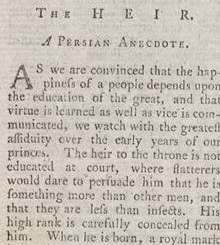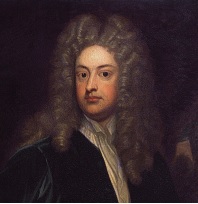As Jennie reminded us earlier this month, we have recently entered the last quarter of the term allotted to our research project. Most of my time currently goes to the attribution of the countless anonymous, initialled and pseudonymous items in the Lady’s Magazine, and the ascription of appropriated content. The overwhelming majority of the over 14000 indexed items were published without a (complete) legal name for their authors, and every day I discover more contributions presented as original work that are in fact tacit appropriations from other periodicals, or extracts from books. To make sure that I do not miss too many of the latter I merge my mind fully with my computer, like some bookish Keanu Reeves, and check each item by means of a hypnotic but productive procedure. A while ago it struck me how different my daily routine must be from that of scholars employed on exactly the same task not twenty years ago. So, where do the differences lie?

LM IV (March 1773). Image © Adam Matthew Digital / British Library. Not to be reproduced without permission.
I usually work as follows. I consult the Lady’s Magazine in its digitized format hosted by Adam Matthew Digital, take two samples from different paragraphs in the item under scrutiny, and query those in three online databases: Google Books, Eighteenth Century Collections Online (Gale), Eighteenth Century Journals (Adam Matthew Digital). On occasion I give British Periodicals (ProQuest) a go, but I have found this more useful for nineteenth-century publications, and for news items I sometimes give British Newspapers 1600-1950 (Gale) and British Newspaper Archive (British Library) a whirl too. In short, I usually have a very cluttered desktop, but there is no alternative if I want to do a decent job. Different databases store different information, and it is definitely worthwhile checking a few. It is common knowledge that magazine staff writers in this period were a crafty bunch, but the Lady’s Magazine’s amateur content pirates can be surprisingly resourceful too, and identifying appropriated items is not always easy because the original sources often were altered ever so slightly. You learn after a while to avoid sampling the opening or closing paragraphs (often added to provide a new context for the appropriation), as well as passages with names or locations in them. In March 1773, for instance, an anonymous contributor to the magazine thinks nothing of making some very minor alterations in an extract from Louis-Sébastien Mercier’s Memoir of the Year Two Thousand Five Hundred (1770; translation 1772), and presenting the result as “A Persian Anecdote” to fit the trend for oriental tales. The original is not “Persian” or otherwise “oriental” in the least; it is in fact a utopian early science fiction narrative.
You cannot trust eighteenth-century periodicals, bless ‘em, and I am sure that despite my vigilance I still miss many appropriations. When I discover that an item is an extract from a book, I will check WorldCat, and the Oxford Dictionary of National Biography or Orlando (Cambridge U. P.) to find out the exact title and year of first publication, and jot those down too. After I feel satisfied that I have checked the item to the best of my abilities, I enter my findings in our annotated index, and go on to the next item. So doing, I learn more about the magazine every day, but like my close colleagues I sometimes get obsessed with individual items. Tracking down the minutest detail can take up hours, and often I never do obtain the information that I was looking for. Jennie, Jenny and I have of course pointed out many times that ours is a tricky task, because data on periodical authorship in the eighteenth century is scarce and patchy at best, and for the ascription of appropriated content we rely to a great extent on textual corpora that have been digitized for cross-reference.
But, hold on a moment. While that last statement will likely not raise any eyebrows among my fellow children of the digital age, the old school of authorship studies will perhaps be appalled by my lack of stamina, by my not spelunking into the dustiest recesses of record offices and research libraries all over the United Kingdom until I have learned exactly what I wanted to know. Although I hope that I am not an armchair antiquary, and the scope of our corpus would make in-depth study of each single item impossible anyway, I make no excuses and do realize that I am spoiled. Of course, academic scholarship has changed over the past few decades too, or so I am told by colleagues of the generation preceding mine, who witnessed these changes first-hand. How many scholars today could find the time to research and write a vast bibliographic tome like Robert Mayo’s The English Novel in the Magazines, 1740-1815 (1962)? Nevertheless, this book is still used today as a reference work throughout the field of eighteenth-century studies. We at least turn to it regularly. Besides its sheer size, what makes Mayo’s study even more admirable is that he produced it before digital resources became available. The first of these appeared only halfway through the 1970s, and until the breakthrough of the internet over twenty years later, they were hardly easy to use or update.
Despite Mayo’s greater fame, there is one pioneering pre-digital scholar whose work in attribution and ascription in periodicals has been even more valuable to me. Even in this computerized age, you will find me about once a week in the British Library, ensconced in a little fort that is constructed largely of books by Prof. Edward William Pitcher (formerly at the University of Alberta). I expect that most of our readers, who have at least dabbled in eighteenth-century magazines themselves, will be familiar with Pitcher’s work. In 1999 he was honoured with a well-deserved special issue of American Notes & Queries (ANQ), a journal which has long published his articles, in which a short laudation by Prof. Arthur Sherbo – no less – goes a long way to explain the importance of Pitcher’s contributions to the field.[1] He has published many indexes, articles and notes on the authorship and provenance of periodical pieces in all genres, which have for a large part been collected in the ongoing series “Studies of British and American Magazines”, issued since 2000 by the Edwin Mellen Press. Impressively, 32 of the 33 book-length volumes published in this series so far are by Pitcher (incl. two co-authored titles). The only other scholar to furnish a single-authored book, incidentally, is Prof. Emily de Montluzin, whose splendid index of the poetry of the Gentleman’s Magazine was an inspiration for our own index.
Pitcher delivers useful emendations to the work of others (among which Mayo), new indexes of important magazines of the eighteenth century from Britain and (colonial and independent) America such as the Lady’s Magazine’s more conservative competitor the Lady’s Monthly Museum (1798-1832), and notes on individual magazine writers or issues in attribution. Because of its centrality in the late-eighteenth century periodical market, the Lady’s Magazine pops up regularly, and some titles in the series have proven especially useful to us. For instance, Pitcher’s The Magazine Sources for Interesting Anecdotes, Memoirs, Allegories, Essays, and Poetical Fragments… by Mr. Addison (London 1794-97) (2004) is an index of the thousands of items compiled in this long-forgotten miscellany (spoiler alert: the reference to “Mr. Addison” is false advertising). Not only does he document several pieces that were taken from the Lady’s Magazine, Pitcher also ascribes several items taken from other sources that in between found their way into the Lady’s Magazine as well. Producing just one such elaborate index would maybe not be very exceptional, but Pitcher has done at least a dozen. His two-volume index of the British Magazine January 1760-December 1767 (2000), to give another example, has likewise shown me the way to several articles extracted without acknowledgement in the Lady’s Magazine, as have several other similar titles in the series. A third particular Pitcher favourite of mine is An Anatomy of Reprintings and Plagiarisms (2000), because its preface and its several chapters that are each dedicated to representative case studies together provide one of the clearest introductions to the murky territory of appropriation in the eighteenth-century press.
I find the tenacity and manifest expertise behind each of Pitcher’s studies, from his most elaborate indexes of leading periodicals to his shortest notes on the obscure hacks that helped make them, nothing short of humbling. Whereas I can rely on internet databases to show me the way towards sources and to provide me with instant access to them, the previous generation had to do much more work themselves. My practical advantages include that I do not need to travel great distances between libraries whose holdings are now but two mouse clicks away from each other, or to peer for hours at microfilms to find out details that can know be had in seconds. I also imagine that the old school required a more extensive working knowledge of their subject than I need to get by; a firmer understanding of eighteenth-century culture as a web of myriads of interacting agents that each leave textual traces behind, coupled with an amazing knowledge of what these diverse traces entailed, where they can be found, and how they should be interpreted.
When our index goes online in a few months (gulp), you will find amongst our thousands of research notes many references to Pitcher’s works. This will be a fitting tribute to a scholar whose life’s work is to ensure that people get due credit for their efforts.
Dr Koenraad Claes
School of English, University of Kent
[1] Sherbo, Arthur. “E. W. Pitcher on Periodicals”. ANQ 12.1 (1999), pp. 2-5


1pondo rina posing porno back
There are certainly still benefits from the old-school methods and the pre-digital age. But there’s hardly anyone bothering to look back in those days.